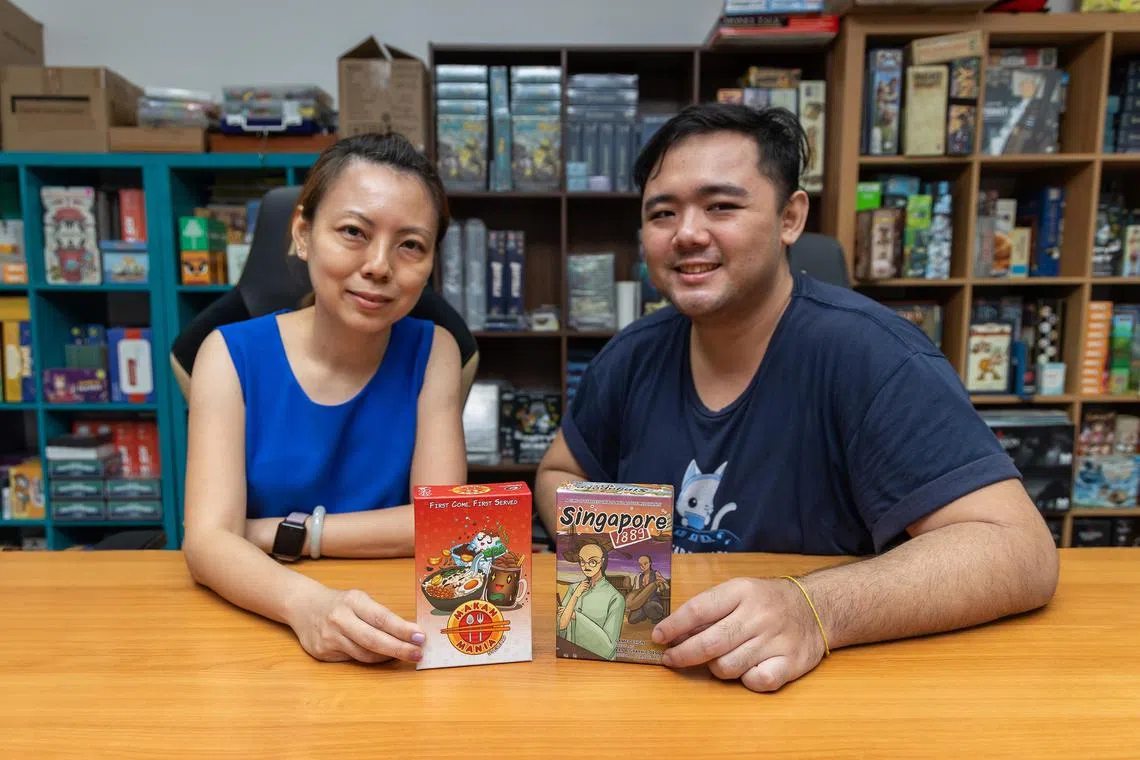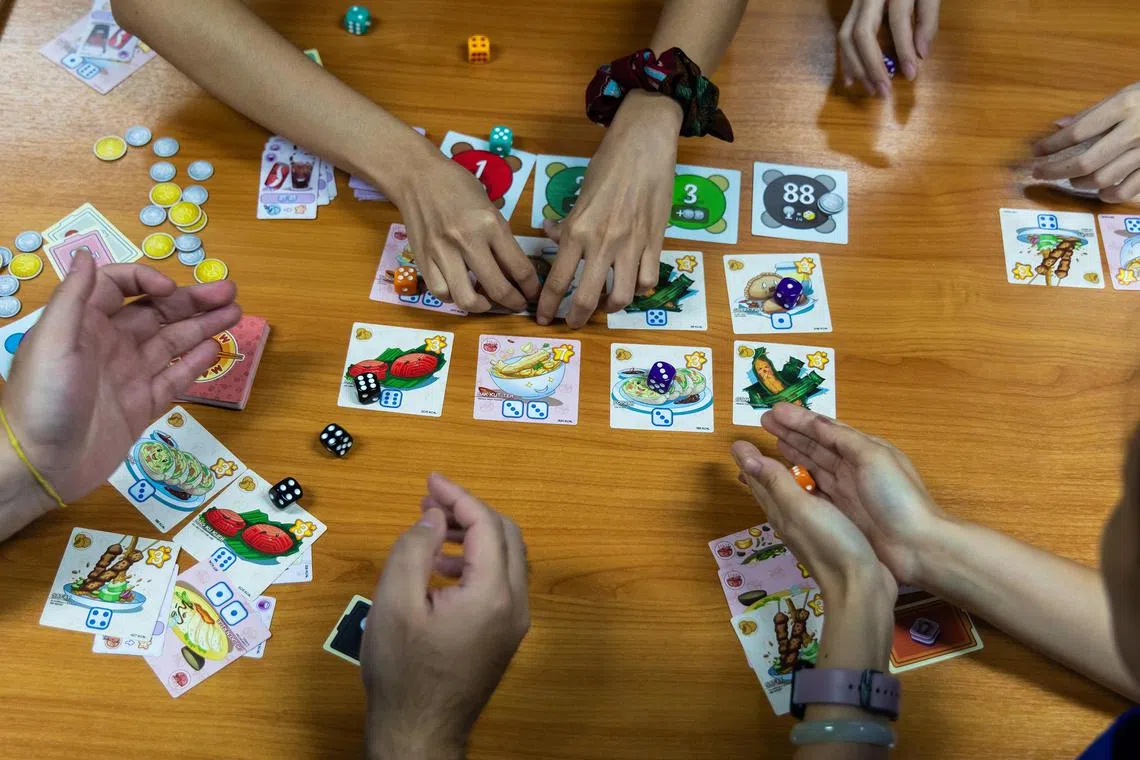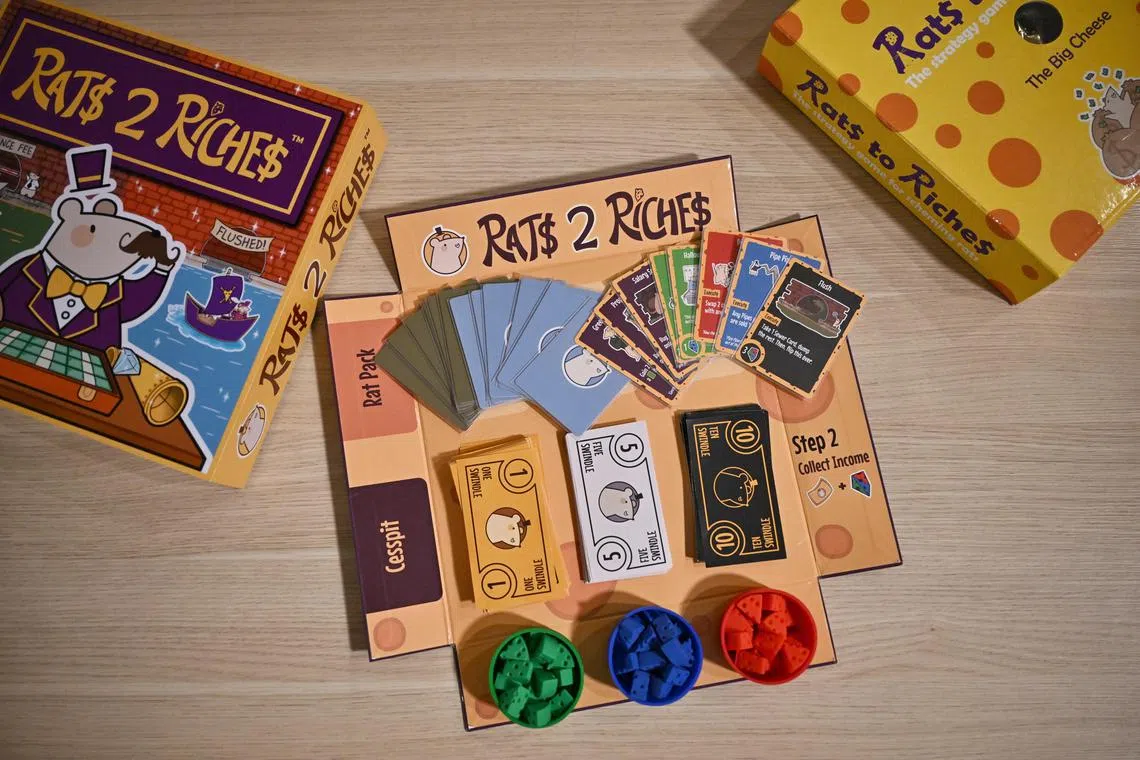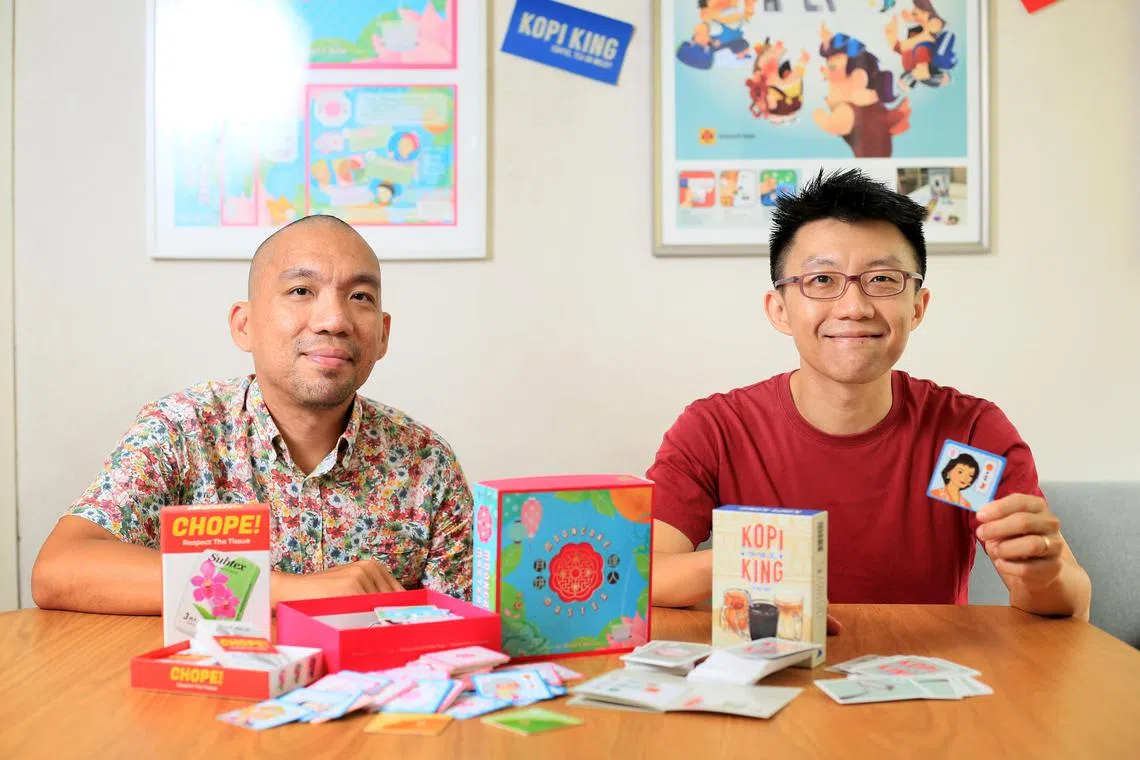Be an Ah Beng or join the hawker centre lunch rush: Singapore-themed card, board games on the rise
Sign up now: Get ST's newsletters delivered to your inbox

Co-founder of Capital Gains Studio Jaslyn Lim and game designer Steve Ng with their latest games – Makan Mania and Singapore 1889.
ST PHOTO: HESTER TAN
Follow topic:
SINGAPORE – The lunchtime rush at a hawker centre is manic and noisy. It involves locating a table, deciding which stalls to queue for and jostling with crowds, all at the same time.
This very Singaporean experience is the premise of Makan Mania, a card game by table-top game designer Steve Ng. In the game, players roll dice to get their food and beat the crowd.
For Makan Mania, which was developed under Capital Gains Studio, Mr Ng said he wanted to have gamers huddled over a table, rolling dice. “It’s the feeling of chance and trying to get lucky. The rolling dice also make noise. It’s exciting, chaotic and, to me, a reflection of the lunch crowd,” said Mr Ng, 29.
Launched in April, Makan Mania is among a growing crop of board and card games made by home-grown designers. Designers and board game cafes tell The Straits Times that interest in table-top games with a local flavour is growing, and this is driving a surge in the popularity of home-grown games over the last five years.

Launched in April, Makan Mania is among a growing crop of board and card games made by home-grown designers.
ST PHOTO: HESTER TAN
Locally made games are gaining ground for a number of reasons, including growing interest in table-top games following the Covid-19 pandemic and the commercial success of some local games and studios, they said.
About 100 copies of Makan Mania have been sold and Mr Ng said it is the studio’s most popular pre-ordered item.
The number of locally made games has soared over the years. Mr Alvin Tan, who owns board game cafe The Mind Cafe, which has two outlets in Prinsep Street, estimates that there were about 120 such games in 2023, up from about 15 in 2013.
Many Singaporeans were exposed to board and card games for the first time during the pandemic, said Mr Tan, 53. “This encouraged many local game designers to develop and publish their very own card games.”
Card game The Singapore Dream allows players to assume different local personas, such as an Ah Beng or a Micro-Influencer. Discomfort, also a card game, has players discussing topics such as religion, politics and sexuality. Discomfort was the first game developed by one of the new kids on the block, House of Many Moons.
Mr Tan attributes the rise of local table-top games to the popularity of The Singaporean Dream, which was developed by SYNT Studio. The game gained a following after its crowdfunding campaign on Kickstarter and collaboration with SGAG, a popular meme site.
The game, which is one of his cafes’ top sellers, allows a player to act as one of several “Singaporean personalities”, and pay and steal his way through to become the perfect Singaporean.
After the success of The Singaporean Dream, more game designers started approaching online platforms and other brick-and-mortar stores, including his cafe, to distribute their games, said Mr Tan.
Crowdfunding platforms such as Kickstarter also make it easier for game designers to raise funds and market their games to a global audience, said Mr Ho Yixian, 38, who started board game cafe King and the Pawn with his wife in 2018.
At such cafes here, where customers gather to play board and card games, local games now make a regular appearance on tables.
Lawyer Ray Lim recently played locally designed finance strategy card game Rats 2 Riches at The Mind Cafe. In the game, players are “sewer-dwelling rats” trying to get rich by investing, buying properties, pursuing careers or stealing.

Customers play locally designed games like Rats 2 Riches at The Mind Cafe.
ST PHOTO: ARIFFIN JAMAR
The 28-year-old, who was surprised to learn that the game was designed by a Singaporean, said: “It was quite understandable, considering that Singaporeans are always in a rat race.”
Despite growing demand for local games, many designers tell ST they cannot afford to do it full-time. Many hold full-time jobs and design games on the side.
Mr Ng said he takes up freelance design jobs from time to time to supplement his income. “It is definitely tough sometimes, but at least I’m doing something that I love,” he said.
Local studio Origame said that while local board games have become more popular in the last five years, there is still a long journey ahead to become truly mainstream.
Origame, which was founded in 2019 by Dr Daryl Chow and Mr Nicholas Pang, both 42, has produced over 20 table-top games. Since it was founded, it has sold about 300,000 games, including its own titles.

Origame, which was founded in 2019 by Dr Daryl Chow and Mr Nicholas Pang, both 42, has produced over 20 table-top games.
LIANHE ZAOBAO file photo
Dr Chow, who holds a PhD in linguistics from the University of Ottawa, said money was a concern during the studio’s first few years. He said making profitable games was “one of the hardest things in the world to do”.
“There is no surefire way to confirm that a game will be profitable, even though we may spend up to a few years making a single game,” he said.
He bemoaned the lack of government support for the board game industry despite the fact that local board games allow players around the world to experience Singapore’s culture.
He noted that over the last few years, “the public attitude towards board games has been slowly shifting and now there are many families that are using board games to grow up together”.
Asked about grants for local games, the Ministry of Culture, Community and Youth (MCCY) said it had previously supported the development of table-top games such as Diversity By Default, Forge Of Nations and CHOPE, BUY, EAT! under various funds and grants.
MCCY added that it will fund projects that “build national identity or meet social and community needs” under the Our Singapore Fund. Game projects can receive up to 80 per cent of supported project expenditure, capped at $20,000, it added.
It can cost between $10,000 to develop a simple card game for 1,000 copies to a high six-figure sum for a complex board game with high-level art, figurines and components, said Capital Gains Studio co-founder Xeo Lye.
Mr Ho, who is developing a Chinese New Year-themed game for 2025, said he will consider applying for government funding.
“However, while cash grants can help to defray the game’s initial production costs, we would prefer collaborations that expand our marketing reach and exposure to build sustainable sources of revenue for the longer term,” he added.


